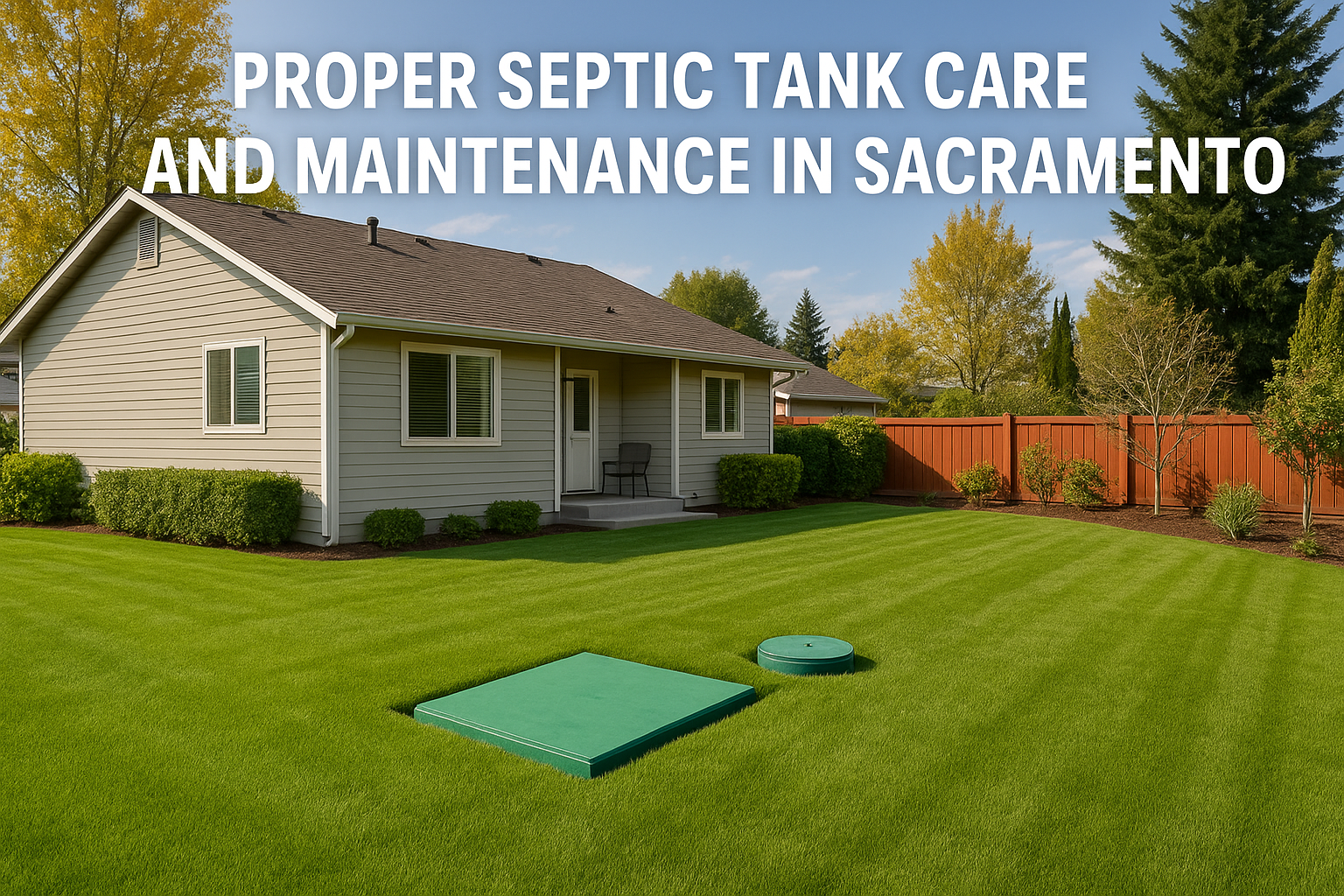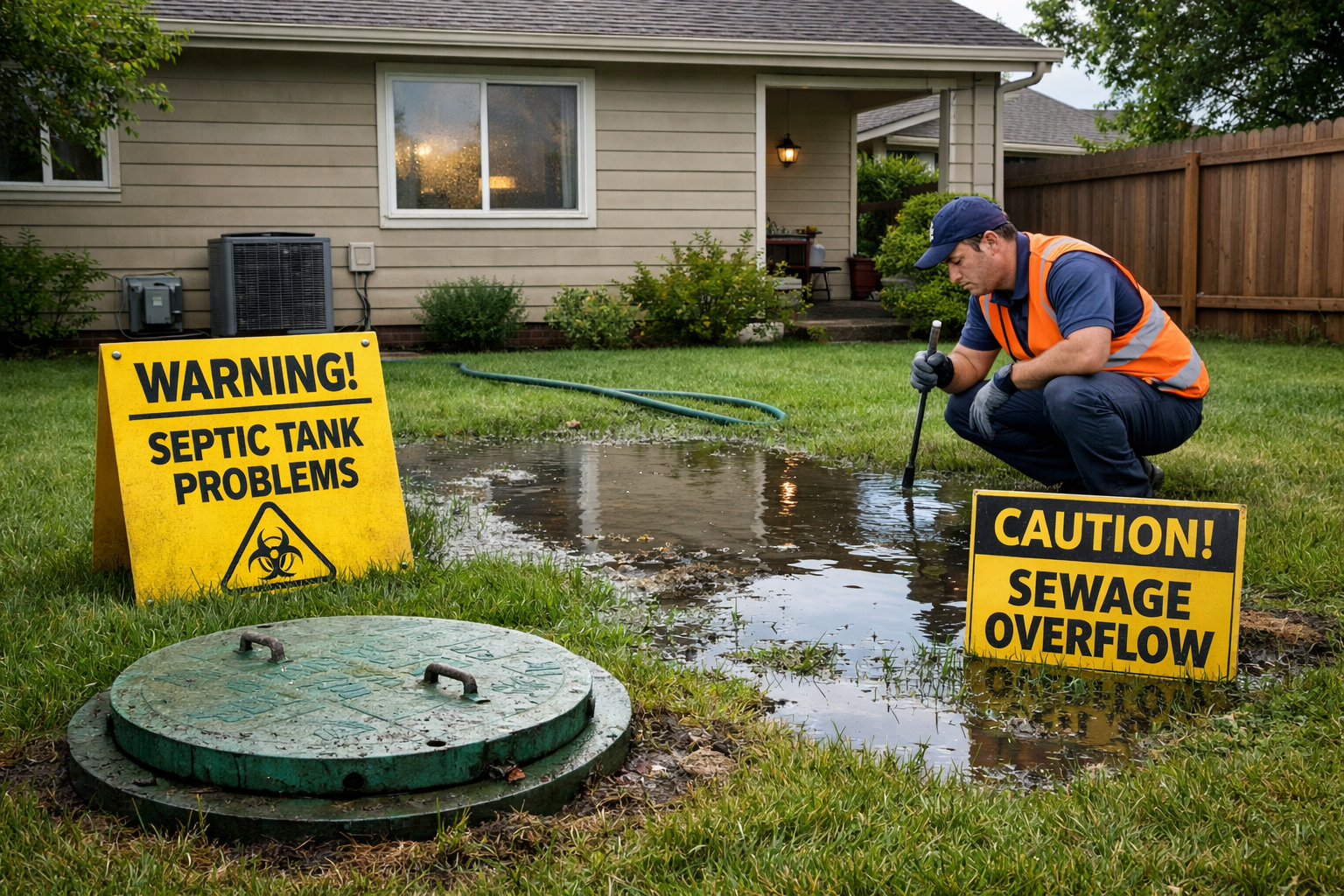Your Essential Introduction to Septic Tank Care in Sacramento
If you’re like most Sacramento homeowners, you probably don’t think much about your septic tank until something goes wrong. But when septic issues hit, they hit hard, backups, foul smells, soggy yards, unexpected repair bills, and serious stress. The good news is that with the right septic tank care habits, you can avoid nearly all of these headaches.
Your septic system works quietly behind the scenes, managing waste, protecting your home, and keeping your property safe. Yet it needs consistent attention to function properly. Many homeowners don’t realize how small daily habits, like flushing the wrong items or skipping pumping, can dramatically shorten the life of a septic system.
In this guide, you’ll learn practical septic tank care strategies tailored to Sacramento CA’s soil, climate, and local system types. By the end, you’ll know exactly what to do, what to avoid, and how to keep your system running for decades.
Let’s dive into the essential steps every homeowner should follow.
Why Septic Tank Care Matters for Sacramento Homeowners
Proper septic tank care is more than routine maintenance, it is essential protection for your home, health, and property value. In Sacramento, where many neighborhoods rely on private septic systems, taking care of your tank ensures your system can handle seasonal weather, soil conditions, and heavy home usage.
When your septic tank is neglected, solids build up, clogs form, and wastewater can back up into your home. Repairs often cost thousands of dollars, and full system replacements can be even more. Regular maintenance helps everything flow smoothly and reduces the chance of sudden emergencies.
Here are a few key benefits of consistent septic tank care:
• Prevents expensive repairs and emergency backups
• Extends the lifespan of your septic system by years
• Helps wastewater process correctly and safely
• Improves long-term efficiency and reduces environmental impact
A common misconception is that septic systems are set it and forget it. In reality, every household activity, from laundry habits to what you put down the drain, affects how well the system performs. With Sacramento's clay-heavy soil and dry summers, proper care becomes even more important because systems struggle more when neglected.
Understanding why septic tank care matters makes it easier to build healthy habits that keep your home safe and your system running as it should.
Essential Septic Tank Maintenance Steps Every Homeowner Should Follow
A smart approach to septic system upkeep starts with knowing what tasks matter most. These steps help you stay consistent and prevent costly surprises.
How to Build a Consistent Maintenance Routine
A strong septic tank care routine starts with knowing what your system needs on a predictable schedule. This type of consistency helps you avoid unexpected damage and keeps your system functioning year-round. Start by adding important tasks to your calendar, such as inspections, pumping appointments, and seasonal checkups. Then evaluate your household habits to see where improvements can be made. As you settle into this routine, maintenance becomes second nature and reduces the risk of serious issues.
For professional pumping and cleaning, you can rely on local experts through the dedicated service at Blue Ribbon Septic Tank Cleaning and Pumping.
How to Protect Your System Through Smart Daily Habits
Your daily habits play a major role in your system’s health. Small actions can either support proper function or lead to major problems down the line. Limit what goes down your drains, especially non-biodegradable items or harsh chemicals that interfere with bacteria levels. Spread out water-heavy activities like laundry to avoid overloading the system. These simple changes help maintain healthy bacteria levels and keep your septic system functioning efficiently without adding extra effort to your day.
If you need guidance on safe products, septic safe cleaning products and expert recommendations from resources like The Spruce can help you choose the right items.
How to Identify the Most Common Warning Signs Early
Spotting early warning signs can save you thousands in repairs and help protect your property. Slow drains, gurgling pipes, foul odors in the yard, or unusually green grass around the drain field often signal developing issues. These symptoms usually point to clogs, backups, or tank overload. When you notice any of these red flags, reach out to a qualified Sacramento septic professional right away. Early detection prevents system failure and keeps your home safe.
To understand system components and warning signs in more detail, visit the helpful guide at Blue Ribbon’s Septic System Overview.
How to Reduce System Stress During Sacramento’s Seasons
Sacramento’s climate influences how your septic system performs throughout the year. Dry summers and rainy winters each bring unique challenges. During hot months, be mindful of water usage to prevent oversaturation of the drain field. When winter rains arrive, make sure gutters and downspouts direct water away from the drain field to prevent flooding and soil compaction. These seasonal habits support long-term system performance.
For lift station support during seasonal changes, local homeowners often turn to Blue Ribbon Lift Station Pumping.
How to Work With a Local Pro for Long-Term Reliability
Partnering with a licensed Sacramento septic technician ensures your system receives expert care. Professionals can identify problems you might overlook and recommend the right maintenance schedule based on your tank size, soil conditions, and household water usage. Regular inspections every one to three years and pumping every three to five years support optimal performance. A trusted professional also gives guidance on upgrades and repairs that keep your system reliable.
For example, improvements like risers and lids can be installed through Blue Ribbon Septic Risers and Lid Installation, and tank locating or baffle replacements can be handled through Tank Locating and Outlet Baffle Replacement.
Real-World Uses for These Septic Care Principles
Now that you understand the essential steps of septic tank care, it helps to see how these strategies appear in real Sacramento homes. A family in East Sacramento adopted water-smart habits, such as spacing out laundry and repairing leaks quickly. Their drain field experienced less stress and their septic pumping frequency improved, giving them nearly another year before the next service appointment. This small change helped prevent issues during the rainy season.
Another homeowner in Citrus Heights noticed gurgling drains and took action based on the warning signs listed above. A quick inspection revealed a clog that could be cleared before causing a major backup. Addressing the issue early avoided costly repairs and prevented contamination on the property.
A third homeowner scheduled routine inspections every two years. Minor issues were detected early, which extended the system’s life by more than a decade. These stories show how consistent septic tank maintenance tips can bring meaningful long-term benefits to Sacramento homes.
Best Practices and Common Mistakes to Avoid
Strong septic tank care goes beyond basic upkeep. Avoiding common mistakes helps safeguard your system and prevents long-term damage.
• Avoid flushing harmful materials
Many homeowners flush wipes, feminine hygiene products, or chemicals without realizing the harm they cause. These items create clogs and reduce beneficial bacteria inside your tank. Keep a trash bin nearby to prevent accidental flushing.
• Limit heavy water usage
Running several appliances at once can overwhelm your septic system. Space out showers, laundry loads, and dishwashing sessions to give your system time to process wastewater properly.
• Protect your drain field area
Never park cars or place heavy structures on your drain field. Compacted soil disrupts filtration and has long-term consequences. Keep landscaping shallow and direct rainfall away from the area.
• Schedule regular pumping
Skipping pumping is one of the most damaging mistakes. Most Sacramento homes need pumping every three to five years depending on tank size and household use. You can schedule detailed system inspections through Blue Ribbon Real Estate Septic System Inspections.
Trusted national resources such as HomeAdvisor, Angi, Forbes Home, and the EPA also provide helpful septic tank maintenance checklist guidance, septic tank odor removal tips, and insight on what drain cleaner is safe for septic systems.
Your Next Steps for Better Septic Care
Caring for your septic system does not have to feel overwhelming. With the right habits, you can reduce the risk of backups, avoid expensive repairs, and keep your home comfortable and safe. From smart daily routines to seasonal adjustments, each step helps extend the lifespan of your system and improves its performance.
Take a moment to review your current habits and choose one or two improvements you can make today. Whether that means scheduling your next pumping, adopting water-efficient practices, learning how to clean a septic tank, or working directly with a Sacramento septic expert, every small change supports long-term reliability.
If you're ready for professional help, Blue Ribbon Septic in Sacramento is the trusted partner you can rely on for year-round service.
Frequently Asked Questions
How often should a septic tank be pumped in Sacramento?
Most Sacramento homes need septic tank pumping every three to five years. The exact schedule depends on tank size, household occupancy, and overall water usage. Regular inspections determine the right timing and prevent solids from building up. Staying on top of pumping is essential for long-term system health.
What are the signs my septic tank needs attention?
Common warning signs include slow drains, gurgling pipes, sewage odors, and unusually lush grass around the drain field. These symptoms can indicate clogged pipes, tank overload, or system malfunction. Addressing these warning signs early reduces repair costs and prevents safety hazards.
Can I use chemical drain cleaners with a septic system?
Chemical drain cleaners should be avoided because they destroy beneficial bacteria inside your tank. Instead, rely on septic safe cleaning products or enzyme-based cleaners when learning how to unclog a septic tank. Maintaining the right bacterial balance ensures effective waste breakdown.
Is it safe to plant trees near my septic drain field?
Tree roots near a drain field can cause serious and expensive damage. If you want landscaping close to the area, choose shallow-rooted plants and keep larger trees at least twenty to thirty feet away. Proper landscaping protects the structural integrity of your system.
What daily habits help maintain a septic system?
Healthy daily habits include controlling water usage, avoiding flushing non-biodegradable items, and using cleaning solutions that support septic safety. Fixing leaks, spacing out laundry loads, and being mindful of household chemicals strengthen long-term performance. These habits support your septic tank maintenance checklist and help keep your system running smoothly.






